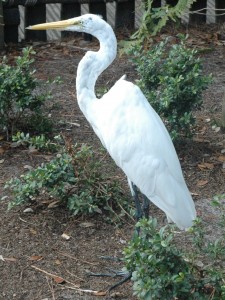Great Egret
The great egret is a summer visitor to upstate New York. Each summer they come up in spring and stay until late October/early November. The great egret is also known as the common egret, large egret or great white heron. It is a widely distributed egret, with four subspecies found in Asia, Africa, the Americas, and southern E urope.
urope.
Great Egret populations have increased across most of their range from 1966 to 2014, according to the North American Breeding Bird Survey, though there appears to have been a decline in Canadian populations. The North American Waterbird Conservation Plan estimates that there are over 180,000 breeding birds on the continent, and rates them at least a 5 out of 20 on the Continental Concern Score. Great Egret is not listed on the 2014 State of the Birds Watch List. During the 19th century great egrets were hunted for their plumes.
What I find interesting is that for such a beautiful bird, its call is usually a low hoarse croak when disturbed, and at nest sites. It can also give a loud croaking cuk cuk cuk and higher-pitched squawks.
Description:

Great Egrets are tall, standing about 3 ¼ feet tall. They are also long-legged, which helps them wade in shallow water. As can be seen from the pictures, the great egret has an S-curved neck and long, narrow yellow bill. In flight, the long neck is tucked in and the legs extend far beyond the tip of the short tail just like a blue heron. The egret’s wingspan can measure 52” – 70”.
As can be seen, great egrets are white. Their bills are yellowish-orange, and the legs black. If you are out bird watching and come across a white egret, the yellow bill with black legs is the important identifier.
In breeding plumage, delicate ornamental feathers are on the bird’s back. Males and females are identical in appearance; juveniles look like non-breeding adults.
Habitat:
Great egrets live in freshwater, brackish, and marine wetlands. During the breeding season they live in colonies in trees or shrubs with other waterbirds, ranging across the southeastern states and in scattered spots throughout the rest of the U.S. and southern Canada. The colonies are located on lakes, ponds, marshes, estuaries, impoundments, and islands.
Territory:
The great egret range has expanded as far north as southern Canada. However, in some parts of the southern United States, its numbers have declined due to habitat loss. The great egret is partially migratory, with northern hemisphere birds moving south from areas with colder winters
Diet:
The great egret feeds in shallow water, marshes and even land. They feed mainly on fish, frogs, small mammals, and occasionally small reptiles and insects, spearing at them with its long, sharp bill most of the time by standing still and allowing the prey to come within its striking distance. Just so it is clear, they do not spear with the bill, they quickly thrust forward and catch the prey in their mouth.
Nesting:
Great egrets are colonial nesters Believe it or not they usually build their stick nests high in trees. You can find them often on islands that are isolated from predators. The nest is up to 3 feet across and 1 foot deep.
The female will lay approximately 1 – 6 smooth, pale greenish blue eggs that are roughly 2” – 2 1/2” long and about 1 1/2” wide. The incubation period is between 23 – 27 days. The young hatch as long and colored white with down covering the back with their eyes open.
Not all young that hatch survive the nestling period. Aggression among nestlings is common and large chicks frequently kill their smaller siblings.